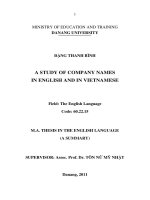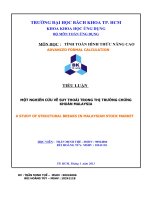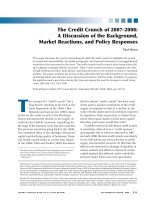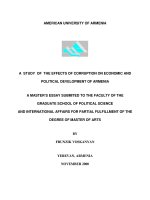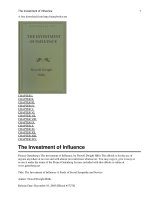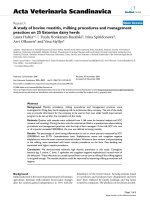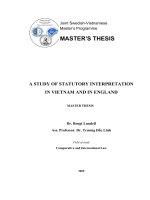A study of chinese stock market empirical and theoretical explorations by bayesian and GARCH models
Bạn đang xem bản rút gọn của tài liệu. Xem và tải ngay bản đầy đủ của tài liệu tại đây (943.49 KB, 152 trang )
A STUDY OF CHINESE STOCK MARKET: EMPIRICAL AND
THEORETICAL EXPLORATIONS BY BAYESIAN AND GARCH
MODELS
CHEN HENG
A THESIS SUBMITTED
FOR THE DEGREE OF DOCTOR OF PHILOSOPHY
OF ECONOMICS
DEPARTMENT OF ECONOMICS
NATIONAL UNIVERSITY OF SINGAPORE
2007
ACKNOWLEDGEMENTS
I am deeply indebted to my supervisor Professor Wong Wing Keung. His precious advices,
supervision and generous support are invaluable and indispensable to the completion of this
dissertation and my academic research as a whole. I am also very grateful to my co-supervisor
Professor Fong Wai Mun and committee member Dr. Lee Jin. Without their inspiring guidance
throughout my candidature, my Ph.D. life could have been an even harder process. My sincerest
thanks also go to graduate director Professor Tilak, my thesis examiners Professor Kapur and Dr.
Gamini, Officers Mrs. Sagi and Ms. Nicky for their kind suggestions and helps during the past
four years. Finally, I have to thank my family for their unremitting patience, encouragement and
understanding which have been underpinning my morale in pursuing the doctoral study.
i
Table of Contents
Acknowledgements i
Summary iv
List of Tables vii
List of Figures ix
Chapter 1: Why do China’s IPOs behave extremely? 1
1.1 Introduction for Chapter 1 2
1.2 Literature review and Hypotheses for China’s market 9
1.3 Briefing on Methodology 26
1.4 Data Features and Empirical Findings 32
1.5 Summary remark for Chapter 1 46
Chapter 2: Is a Superpower More Important than a Neighbor?
An Application to China’s Stock Market 48
2.1 Introduction for Chapter 2 49
2.2 Literature review and motivations 52
2.3 Data and Methodology 57
2.4 Empirical Results 67
2.5 Summary remark for Chapter 2 82
Chapter 3: A remedy to the flaw of GARCH and Applications to China’s and US
Markets 84
3.1 Introduction for Chapter 3 85
3.2 The flaw of GARCH and a remedy model 91
3.3 The algorithm for estimating stochastic volatility models 97
ii
3.4 Empirical evidences 106
3.5 Summary remark for Chapter 3 118
Chapter 4: Conclusions 120
Bibliography 124
Appendix A 137
Appendix B 139
Appendix C 140
Appendix D 141
Appendix E 142
iii
Summary
This study on Chinese stock market consists of three essays laid out as three chapters.
The first essay tries to decipher the extreme behavior of China’s initial public offerings (IPOs).
The short-run underpricing and long-run overpricing of IPOs observed in almost all stock
markets are puzzling phenomena in theoretical as well as practical finance. The more challenging
situation is that IPOs on developing markets appear to behave more abnormally than those of
developed markets. Especially, China’s market presents the most extreme IPO facts ever
documented in literature. Based on the close observations of China’s market, we propose that
price manipulation, information asymmetry, hot market and hot issue effects and signaling
practice could predict much of the underpricing and long run buy-hold returns of IPOs on
China’s market. Among these explanatory factors, price manipulation and information
asymmetry arising from privatization process are unique to China’s transitional economy. In
addition to the traditional analysis, Bayesian approach which is not much pursued for this
purpose is also employed to draw inferences from long run return regression. Our empirical
results verify our conjecture that large part of IPO initial return and long run buy-hold return is
due to institutional defects of China’s market.
The second essay investigates the bilateral cointegration relations between China’s and
US stock markets, and between China’s and Hong Kong stock markets. Research on
cointegrations among stock markets has important practical implications for portfolio
management considering the increasing globalization among international financial markets. Due
to economic and geographical considerations, US and Hong Kong are closest stock markets to
China, thus understanding the integration between China and these two markets could have
iv
important implications for policy makers as well as investors. Because usual vector error
correction model (VECM) may overlook the long memory feature of cointegration residual
series which may biases resulting inferences, we employ fractionally integrated VECM
(FIVECM) to investigate the cointegration relations binding China’s stock market to the other
two stock markets in the long run. Additionally, by augmenting the FIVECM with multivariate
GARCH model, the return transmission and volatility spillover between market return series are
revealed simultaneously. Our empirical results show that China’s stock market is fractionally
cointegrated with the other two markets, and it appears that China’s stock market has stronger
ties with its neighboring Hong Kong market than with world’s superpower, US market.
The third essay discusses a flaw of GARCH model and provides a remedy to improve the
volatility fitting of GARCH-type model. Since its birth about twenty years ago, GARCH model
has incurred a vast body of literature and experienced explosive empirical applications, largely
due to its structural beauty and computational tractability. More importantly, GARCH model is
well acclaimed because of the capability of capturing clustering effect typical of financial time
series. However, the most prominent merit of GARCH model turns out to be a demerit as well.
This chapter shows that inclusion of lagged squared residuals in GARCH model artificially
generates slow decay of volatility following large shocks. As large shocks to financial series are
usually followed by much quieter periods, the slow decay and response of volatility are in
obvious contrast with market efficiency assumptions. With detailed arguments, we propose that
stochastic volatility model could overcome the flaw of GARCH model. The empirical results
using return series of both S&P 500 and China’s stock index have confirmed that stochastic
volatility model indeed provides a better fitting on conditional volatility process than GARCH
type models. An asymmetric stochastic volatility model has also been proposed and fitted to the
v
data sets. Interestingly, the opposite conclusions about the leverage effect in asymmetric model
fitted on two return series indicate different speculative features and trading behaviors on the two
major stock markets. Another contribution of this chapter is that we design a simple yet effective
Markov Chain Monte Carlo (MCMC) algorithm to estimate the stochastic volatility models with
Bayesian approach. Summarizing remark for each essay is given at the end of each chapter, the
final conclusions for the whole study are made in chapter 4.
vi
List of Tables
Table 1.1: International evidence on IPO underpricing 3
Table 1.2: Average IPO underpricing on China’s market 5
Table 1.3: IPO underpricing in China by year 34
Table 1.4: Variables used in Chapter 1 and short descriptions 35
Table 1.5: Descriptive statistics for the variables in Chapter 1 35
Table 1.6: Correlations among variables used Chapter 1 37
Table 1.7: The estimated results for the underpricing regression model (1.15) 39
Table 1.8: The MCMC results for half year return regression (1.22) 44
Table 1.9: The MCMC results for one year return regression (1.23) 44
Table 2.1: Descriptive statistics of data in Chapter 2 58
Table 2.2: Unit root tests for index series in Chapter 2 68
Table2. 3: DOLS model estimates, dependent variable is “ ” 68
t
SHH
Table 2.4: Stationarity and long memory tests on cointegration residuals 70
Table 2.5: ARFIMA fit results 70
Table 2.6: Estimates for FIVECM-BEKK(1,1) fitted on
),(
′
Δ
Δ
tt
SPSHH
71
Table 2.7: Model diagnostic statistics for
t
SHH
Δ
and
t
SP
Δ
75
Table 2.8: Estimates for FIVECM-BEKK(1,1) fitted on
(
76
)
′
ΔΔ
tt
HSSHH ,
Table 2.9: Model diagnostic statistics for
t
SHH
Δ
and
t
HS
Δ
79
Table 3.1: Fitted variances around first spike on S&P 92
Table 3.2: Fitted variances around second spike on S&P 92
Table 3.3: Parameter Estimates for SV model on S&P 107
Table 3.4: Fitted variances from SV around first spike on S&P 108
vii
Table 3.5: Fitted variances from SV around second spike on S&P 108
Table 3.6: Parameter Estimates for Asym. SV on S&P 109
Table 3.7: Fitted variances from Asym. SV around first spike on S&P 110
Table 3.8: Fitted variances from Asym. SV around second spike on S&P 110
Table 3.9: Fitted variances around first spike on SHH 113
Table 3.10: Fitted variances around second spike on SHH 114
Table 3.11: Parameter Estimates for SV model fitted on SHH 114
Table 3.12: Fitted variances of SV around first spike on SHH 115
Table 3.13: Fitted variances of SV around second spike on SHH 115
Table 3.14: Parameter Estimates for Asym. SV fitted on SHH 116
Table 3.15: Fitted variances of Asym. SV around first spike on SHH 117
Table 3.16: Fitted variances of Asym. SV around second spike on SHH 117
viii
List of Figures
Figure 2.1: Stock indices of China, USA and Hong Kong 58
Figure 2.2: SACF of cointegration residual series between China and US 69
Figure 2.3: SACF of cointegration residual series between China and HK 69
Figure 2.4: Conditional Standard Deviations for
t
SHH
Δ
and
t
SP
Δ
73
Figure 2.5: Conditional correlation between series
t
SHH
Δ
and
t
SP
Δ
74
Figure 2.6: Conditional Standard Deviations for
t
SHH
Δ
and
t
HS
Δ
78
Figure 2.7: Conditional correlation between series
t
SHH
Δ
and
t
HS
Δ
79
Figure 2.8: Impulse Response Function of
(, ,
tt t
SP HS SHH )
′
Δ
ΔΔ
80
Figure 3.1: Implied ACF of fitted models on S&P 112
Figure 3.2: Implied ACF of fitted models on SHH 118
ix
Chapter 1: Why do China’s IPOs behave extremely?
Key words: Initial public offering (IPO), Stock market, Underpricing, Overpricing,
Bayesian approach
1
Section 1.1: Introduction for Chapter 1
The significant underpricing in Initial Public Offerings (IPO) is one of the widely known
wonders in finance field, and it has been documented for almost every market, both developed
and emerging markets. Because the recurrent presence of IPO underpricing is in obvious contrast
with market efficiency assumption
1
,
2
, it has incurred ardent research attention and tremendous
literature during the past three decades or so. However, like other financial theories, it is still far
from being utterly settled. Roughly, researches on IPO have focused on two abnormal facts
pertaining to IPO, namely short-run underpricing and long-run overpricing
3
. Some papers have
characterized the coexistence of the two phenomena as a puzzle (Loughran & Ritter (1995)).
Most recent papers on IPO focus on this puzzle and examine the two anomalies together.
Short-run underpricing or high initial return
4
in IPO means that positive initial return of
IPO is large, considerably higher than market return on the same trading day. Specifically, on
average, the closing price of a newly listed stock on the first trading day is significantly higher
than the IPO offering price, which leads to much money left on the table for the IPO investors
who bought the stock on the primary market
5
. Ibbotson et al (1988) document the average initial
return of 16.4% for IPO sample going public in 1960-1987 on U.S. market. International
evidences of underpricing are shown in various studies, summarized in such studies as Loughran
et al (1994) and Ritter and Welch (2002), and Table 1.1 below lists IPO underpricing levels for
various markets collected from various studies.
1
Of course, the market efficiency itself is still a topic of dispute.
2
However, some authors claim that the efficient market hypothesis is applicable to IPO stocks in the long run, see
for example, Bossaerts and Hillion (2000).
3
It is also called long-run underperformance.
4
IPO underpricing and IPO initial return are used interchangeably in this chapter.
5
The primary market refers to the IPO issuance stage on stock market.
2
Table 1.1: International evidence on IPO underpricing
Country Source Sample Size Time period
Average Initial
Return %
Brazil Aggarwal & Leal(1993) 62 1979-90 78.5
Canada Jog & Srivastava(1994) 258 1971-92 5.4
France
Husson&Jacquillat(1989)
Leleux & Muzyka(1994)
187 1983-92 4.2
Germany Ljungqvist(1997) 170 1978-92 10.9
Japan Hebner & Hiraki(1993) 472 1970-91 32.5
Korea Dhatt et al(1993) 347 1980-90 78.1
Netherlands Eijgenhuijsen & Bujia(1993) 72 1982-91 7.2
Australia Lee et al(1996) 266 1976-89 11.9
Thailand Wethyavivorn & Koo(1991) 32 1988-89 58.1
UK Levis (1993) 2,133 1959-90 12.0
Ibbotson et al (1988) 10,626 1960-87 16.4
US
Booth &Chua (1996) 2,151 1977-88 13.1
An interesting fact about the international evidences is that IPO underpricing in
developing markets is usually substantially larger than those observed in developed markets.
Also, the magnitude of underpricing is time varying, it presents much fluctuation from time to
time. At some point of time, measured average initial returns are even much higher. Such huge
initial returns have triggered a lot of curiosities among academicians as well as practitioners.
A lot of explanations have been proposed in literature to unpuzzle the anomaly of IPO
underpricing. The representative propositions for IPO underpricing are Winner’s curse(Rock,
1986), Signaling model(Welch, 1991), Agency-cost assumption(Baron, 1982), Avoidance of
legal liability(Tinic, 1988), Price stabilization and manipulation (Aggarwal, 2000), conflict of
interest assumption (Loughran & Ritter, 2002), Ownership dispersion and monitoring(Booth &
Chua, 1996) and some others. These propositions are sorted by Ritter & Welch (2002) roughly
into two categories, one is based on asymmetric information assumption, whereas the other
presumes symmetric information among the three main parties involved in IPO process, namely
issuer, underwriter and investor. Generally, researchers make particular assumptions about the
3
three parities and try to answer such questions as why issuers like to intentionally underprice IPO,
what reasons drive the investors to keep paying fabulous price to buy IPO and what role
underwriters possibly play in the amazing underpricing mystery. However, every such theory
interprets the problem from a specific perspective, the effectiveness of theories is case sensitive,
and none of them is overwhelmingly dominant over others. Therefore, some researchers try to
seek answers from IPO allocation process itself or microscopic market structure, which has been
identified as one of the most promising possible reasons for deciphering IPO puzzle, see Ritter
and Welch (2002). Further, some authors suppose that the initial underpricing of IPO stock
directly induces its long-run underperformance which is the result of downward adjustment of
price from the overshooted closing price on the first trading day back to its long-run equilibrium
level
6
. The next literature review section will elaborate on some typical theories and their
implications for the current study on China’s market.
Long-run aftermarket overpricing of IPO stocks
7
is also extensively studied, one
systematic investigation is done by Ritter (1991). Long-run overpricing says that, on average,
long term(excluding the first trading day) buy-hold return of IPO stocks is lower than the market
return in the same time span, also lower than buy-hold return of comparable seasoned firms.
Studies usually examine two abnormal returns, one is the market-adjusted return which is buy-
hold returns of IPO stocks adjusted by broad market index, and the other is benchmark
adjusted(or style-adjusted) return which is buy-hold returns of IPO stocks adjusted by buy-hold
return of comparable firms. In Ritter’s paper, average three year buy-hold return of IPO stocks,
going public during 1975 through 1984 on U.S.A market, underperforms the matching firms by
over 26%. Conditioning on industry, proceeds size, initial return magnitude and firm age, the
6
This phenomenon is called the burst of speculative bubble, see Aggarwal and Rivoli (1990) for Speculative Bubble
Hypothesis.
7
IPO stocks refer to the IPOs just getting listed.
4
average underperformance of IPO stocks is still substantial. In a review paper, Ritter and Welch
(2002) record market-adjusted average 3-year buy-hold return for IPO stocks issued during
1980-2001 is -23.4%, whereas that of matching-firm is -5.1%. The cross country evidences of
aftermarket performance are dependent on the length of return period.
T
As said above, the efficacy of theories on IPO is illusive from case to case, furthermore,
they become less powerful when applied to the more extreme cases in developing markets. The
IPO stories in developing markets are similar except that both short-run underpricing and long-
run overpricing are more severe, and the price behavior of IPO stocks is more volatile. The
average IPO underpricing recorded in literature is higher than 50% for almost all developing
markets. The most extraordinary figure comes from Su and Fleisher (1999), who claim average
initial return of 948.5% for China’s IPOs issued from 1987 through 1995. Other papers on
China’ market also document average IPO initial return higher than 130%, Table 1.2 below list
some magnitudes of IPO underpricing based on different samples on China’s market.
Table 1.2: Average IPO underpricing on China’s market
Country Source Sample Size Time period
Average Initial
Return %
China Mok & Hui(1998) 87 1992-93 289.0
China Su & Fleisher(1999) 308 1987-95 948.6
China Liu & Li(2000) 781 1991-99 139.4
China Chen, Firth & Kim(2000) 277 1992-95 350.0
China Chi & Padgett(2002b) 668 1996-00 129.2
China Loughran et al(2006) 432 1990-00 256.9
Using IPOs sample spanning 1998 through 2003, this chapter obtains market-adjusted
mean initial return of 127.6%, also much higher than those of any other markets. Similarly, the
long-run underperformance of IPO stocks on China’s market is also remarkable. Using the same
sample, this chapter obtains average one year raw buy-hold return of -3.65% for IPO stocks,
whereas the average market-adjusted one year buy-hold return is -3.18%. This implies that the
5
investors on China’s market who buy IPO stocks at the closing price of the first trading day and
hold for one year would, on average, lose 3.65% of their investment. While most of studies assert
that IPO stocks usually underperform broad market on mature stock markets, studies on the
pattern of long-run returns of China’s IPO stocks do not reach consensus in this respect. Chen et
al(2000) show that IPO stocks listed during the early years of China’s market underperform the
market index in term of three years buy-hold returns, whereas Chi and Padgett(2002a) get the
opposite conclusion using different sample of China’s IPO stocks. However, the discrepancy
should be interpreted with caution given the awfully volatile market of China throughout its
history. A number of attempts have also been made to expound the startling long-run
underperformances of IPO stocks, the next section will give some review and propose our
conjectures about the issue on China’s market.
Given the extreme facts about China’s IPO, the questions naturally arising are what cause
the outrageous IPO underpricing on China’s market? Can the existing theories in the literature be
applied to China’s market? In order to answer these questions, we have to first understand
China’s special market mechanisms. Stock market was introduced to China about fifteen years
ago to help reforming centralized economy. Due to the transitional nature of economy, China’s
stock market has some peculiar features which are alien to mature and other emerging markets as
well. Although stock market has been well established for a long time in many countries, China’s
infant market has since its right inception been subject to loophole-prone regulatory system due
to lack of experience and institutional defects. In addition, large amount of information
asymmetry characterizes the privatization or decentralization process via stock market.
Consequently, rent seeking activities in various forms and illegal transactions are prevalent in
China’s stock market. Indeed, Su and Fleisher (1999) and Gu (2003) test a bribery hypothesis on
6
China’s IPO market, albeit only the later author supports the proposition. Ignoring this unique
market structure could bias any inferences about China’s IPO and IPO stocks. Bearing this
perception into mind, this chapter tries to discover some powerful predictors for the behavior of
IPO initial returns and one year buy-hold returns of IPO stocks on China’s market. In addition to
conventional propositions, this chapter interprets the returns of China’s IPO and IPO stocks from
some perspectives directly based on the observations of China’s market. With proxy variables for
information asymmetry, price manipulation, hot market and hot issue effects, we find some
strikingly close relations between IPO initial and aftermarket returns and abovementioned
market imperfects. Our analyses verify our hypotheses that large part of the variability of IPO
initial and aftermarket returns on China’s market is driven by the deficient market structure. In
other words, the high IPO underpricing on China’s market is created artificially rather than
originates from fundamental reasons like good quality and promising growth prospects of listed
companies.
There are mainly two motivations which prompt us to study the IPOs on China’s market.
Firstly, the aforementioned unique institutional backgrounds provide an ideal context for us to
investigate the special price behavior of IPO within China’s transitional economy in which both
socialist and capitalist economic mechanisms are operating in combination or in competition
with each other. Our second concern is that although there are arising attentions on China largely
because of its ceaselessly growing economy, academic researches on China’s stock market
mount up moderately. The possible reasons include the difficulty to acquire data in desirable
format as economic and financial data on China’s market remain primitive and fragmented, and
also possibly because academic attention still lingers around the developed markets as China is
still a would-be superpower, not a real one. Nevertheless, there are some published papers on
7
China’s stock market and IPOs including some of those listed in Table 1.2, Bao &Chow (1999)
and Aharony et al(1999) are the additional. However, most of earlier studies mainly focus on the
early stage, prior to 1998, of China’s stock market. Instead, the data used in this chapter sample
from 1998 through 2003 covering the period when China deepened financial reforms in order to
enter WTO which include introducing a series of new policies for IPO market such as repealing
annual quota for IPO, shortening time gap between offering and listing, enforcing book-building
practice and adopting over-allotment scheme. Therefore, inferences drawn from this sample
could have some illustrative effects for investors as well as prospective design of China’s
primary stock market.
Both traditional least squares and Bayesian methodologies are employed in this chapter to
carry out multiple regression analyses. While it has been widely applied in such fields as biology
and statistics, Bayesian analysis is not much pursued in economics and finance. Due to its
capability to update information, Bayesian approach is especially suitable for conducting long
horizon inferences, and as shown by Brav(2000), it could correct some biases resulting from
traditional analysis used in this case.
The rest of this chapter is organized as follows. Section 1.2 will review some literature
for expounding IPO puzzle and their implications for China’s market; meanwhile, some
hypotheses about the China’s IPOs to be tested in later text are postulated. Section 1.3 briefly
introduces the methodologies used in this chapter, especially the Bayesian inference which is
relatively new in financial application. Detailed data features and empirical results are shown in
section 1.4. Section 1.5 draws summary remark about the chapter 1.
8
Section 1.2: Literature review and Hypotheses for China’s market
Since the literature on IPO is so voluminous, it is difficult to give a comprehensive
review. Thus, we focus on the most acclaimed hypotheses proposed by various authors, then we
present specific hypotheses which are deemed relevant for China’s market and will be tested in
the next section. We divide our narrative into two parts; the first one focuses on underpricing,
whereas the other is about long run overpricing.
1.2.1 Theories and hypotheses about IPO underpricing
1.2.1.1 Signaling hypothesis
The first influential hypothesis put forward to explain the IPO underpricing is signaling
assumption. It supposes that the issuer is better informed than investors about the value of the
offering, thus good issuer likes to signal its quality by intentionally underpricing IPO to impress
investors. Then high quality issuers will be redeemed by issuing subsequent equities, namely
seasoned equity offerings (hereinafter SEO) at higher prices. At the same time, they can preclude
some free-riders from low quality issuers, because the latter cannot afford to imitate. Therefore,
researchers usually test the signaling hypothesis by estimating the likelihood that IPO issuers
with high underpricing return to market to issue SEO. Welch (1989), Grinblatt & Hwang (1989)
and Chemmanur (1993) find some evidence in support of signaling assumption, whereas
Michaely and Shaw (1994) do not favor it. Su (2004), using Probit model, provides some
evidence for the presence of signaling process on China’s market. However, in practice, it is
widely known that the decision to issue SEO heavily depends on the overall market condition of
the time, thus the timing of subsequent issuance should be more crucial than the level of initial
IPO underpricing, especially when the listing date of IPO passed sometime back from the
decision of SEO. Therefore, the influential effect of aftermarket price immediately prior to SEO
9
decision has also to be accounted when testing signaling capacity of IPO initial return. On
theoretical and practical grounds, the real need of funding to finance new development project
seems to be more reasonable determinant of decision to issue SEO. Further, it is unclear why
high quality issuers have to sacrifice some proceeds in IPO, then to recoup it from SEO. They
could issue both IPO and SEO at high prices, because if they are really of high quality before and
after the date of IPO, investors are inclined to pay high price for its IPO as well as SEO. “The
good will be better” is one of paramount mottos for most investors. Otherwise, if its quality dives
down after IPO, investors will definitely flee away.
As to the China’s case, the major reason of establishing stock market is to privatize
highly centralized economy. In certain sense, the privatization is interests-redistribution among
central government, local government and individuals (mainly company managers and
employees), so the local government and company management desire to have domiciled
companies under their presiding getting listed in stock exchanges. However, in the early stage of
China’s stock market, only a small number of companies determined by annual quota can go
public and be listed every year. Therefore, the annual quota itself became the target of fierce
competition and the source of rampant corruptions. Moreover, the not-uncommon practice of
China’s IPO issuers is that they snatch money from IPO, then they do not utilize IPO proceeds in
accordance with stipulations in prospectus, but do some speculative businesses, also they seldom
distribute dividends to investors. Thus, it is hard to justify that China’s IPO issuers are willing to
signal their value by underpricing IPO for the purpose of issuing subsequent SEO at high price.
Nevertheless, we believe that IPO issuers are willing to signal their good quality to
investors, probably not for the distant intention of returning to market for more funding, but just
for ensuring the IPO issuance a success. They could signal their distinguished quality to solicit
10
more investors and more subscription to their IPO, which in turn may lead to high underpricing.
In other words, underpricing is the result of signaling action, rather than a resort to implement
signaling. Among the ways to exhibit issuers’ good quality to potential investors, P/E (offering
price/earning per share) ratio of IPOs is the favorite instrument. The denominator of the ratio
refers to the EPS which is weighted average of past (around 2 years) and forecasted earnings per
share
8
. The price of IPO on the China’s market is set as E*P/E, the high P/E ratio could signal
good quality and confidence of management in the growth prospect of the company, thus could
entice floods of investors from both primary and secondary markets. As a result, initial return or
underpricing on the first trading day might well be pushed to a lofty level. Some studies have
documented the positive relations between P/E ratio and IPO underpricing on China’s market,
but under different context of reasoning
9
. To test the signaling function and the impact of P/E on
underpricing on China’s market, we postulate:
Hypothesis I: High P/E ratio results in high IPO underpricing, ceteris paribus.
1.2.1.2 Winner’s curse
The second important hypothesis for IPO underpricing is the winner’s curse
10
(Rock,1986; Welch, 1992) faced by investors. In contrast to the signaling hypothesis, winner’s
curse assumes that investors are better informed than the issuer, and all investors are not equally
knowledgeable about the IPO. To obtain all requested IPO allocation, successful investors have
to bid a higher price than others, in most cases, the successful price reflects overoptimism of
market about the offering. If one IPO is hot, too many investors desire it and oversubscription
happens, the IPO will be allocated by rationing rather than by adjusting price. Furthermore,
8
The setting of EPS has repeated several changes on China’s market, going from average earnings during the past
years prior to IPO, forecasted earning to average of past and forecasted earnings.
9
Like Chen, Firth & Kim(2004) and Bao & Chow(1999).
10
Winner’s curse is the dilemma facing successful buyers in auction who usually pay too high price.
11
informed investors bid high price only for good IPOs which will probably have high
underpricing, but may not actively purchase IPOs which they consider are not worth much and
likely to be overpriced. Therefore, uninformed investors are more likely to receive full allocation
of overpriced IPO than underpriced ones; in other words, uninformed investors are adversely
treated in IPO allocation. Bearing this in mind, investors with clear information about the
demand for the IPO may not be inclined to bid a desired price or truthfully reveal to issuer or
underwriter their intense interests to buy the IPO; and the reluctance of informed investors would
be contagious to uninformed investors who do not know much about the issue. Consequently,
issuers have to necessarily underprice the IPO to compensate informed investors for them to
voluntarily bid high prices, and to attract uninformed investors to participate in IPO purchases.
The purposive self-sacrificing underpricing could be done through book-building process during
which if strong demand for IPO is anticipated, issuer and underwriter will not fully adjust
upward the predetermined offering price and leave the IPO underpriced, see for example Bradley
& Jordan (2002).
“Winner’s curse” is also not conformable with some obvious rational assumptions about
issuers’ behavior. Since IPO are usually heavily oversubscribed (see Benveniste & Spindt
(1989)), there are no quite logical reasons for issuers to throw much money away by self-driven
underpricing. Nevertheless, this hypothesis is supported by some studies, for example, Michaely
& Shaw (1994) endorse winner’s curse using U.S. data in late 1980’s. The key reasoning of
winner’s curse implies that information asymmetry between issuers and investors forces issuers
to intentionally underprice their IPO, in order to make the issue process easy and smooth.
On China’s market, this kind of information asymmetry is more severe than other
markets because of some special features inherent in China’s economy. Most of China’s
12
companies are owned or controlled by governments (central or local or jointly). Typically, when
these state-owned enterprises (hereinafter SOEs
11
) issue IPOs, governments still retain control of
the companies by holding a large fraction of shares in the forms of state shares and legal entity
shares
12
, only a small proportion of shares are offered to public investors and traded in
exchanges, called A-shares. IPO in China’s market means issuing A-shares
13
. On China’s market,
tradable A-shares approximately account for only one thirds of total shares issued domestically.
Therefore, the information asymmetry among issuers (governments or legal entity shares
holders), informed investors (institutional investors) and uninformed investors (public share
holders) is magnified by this unique ownership structure. Specifically, information uncertainty of
SOEs to investors stems from two sources. On the one hand, non-transparency and inefficient
management of SOEs make outsiders know very little and even have some suspiciousness about
them. On the other hand, large fraction of shares retained by government would make investors
unsure about its’ pro-market privatization commitment (As argued in Perotti (1995)) which
haunts investors’ mind in such transitional economy as China
14
, and would also increase ex-ante
incertitude about the issuer.
Given this large degree of information asymmetry on China’s stock market, winner’s
curse theory implies that government has to compensate public investors in the form of
underpricing when they issue IPO. Otherwise, poor market participation in the IPO process could
11
The acronym is different from SEO above which refers to the seasoned equity offerings.
12
These shares which are similar to shares retained by original owners of listed company in western markets, not
negotiable and tradable, yet enjoy same rights as tradable shares. Whereas, right now, China’s government is
converting the non-tradable state shares alike to tradable shares, in order to scale-up privatization and render China’s
stock market closer to standard mature markets.
13
Some Chinese companies also issue shares to foreign investors, called B-shares, traded in domestic exchanges but
quoted in US$ or HK$. As B-shares behavior quite differently from A-shares, this chapter does not study B-shares.
Also, B-shares are going to be abolished and consolidated with A-shares according to publicized official agenda.
14
Some opposing argument about the high equity retention is also suggested. Mok & Hui(1998) say that high equity
retention by China’s government could act as a guarantee to investors, as it is said that government will not allow
listed SOEs to collapse by all means. They should assess the validity of the alleged guarantee, however.
13
foil government’s attempts to privatize or disperse ownership. Therefore, the reasonable
hypothesis would be that if SOEs want to issue larger portion of shares (A-shares) to public
investors, they have to underprice the IPO more in order to ensure the issuance a success. This
argument is also in line with that of Booth & Chua (1996) who claim that liquidity incurred by
wider ownership structure is desired by issuers. Baron (1982) also shows that underpricing could
be employed by issuer to make IPO sales much easier and reduce the risk of the underwriter
having to buy unsold IPO in firm commitment issuance which is mostly employed in issuing
IPOs on China’s market. For China’s market, Zhang et al(2000) and Chen et al(2000) provide
some evidence that listed companies with higher equity retention by government perform better
in both initial return as well as long term buy-hold return than the stocks with lower equity
retention, their interpretations are different from assumption of winner’s curse, however.
Because China’s authority is trying to enlarge the privatization scale by gradually converting
non-tradable shares (state and legal entity shares) to tradable shares (A-shares), high market
liquidity is expected by government. Therefore, this chapter tests the winner’s curse hypothesis
on China’s market by including the ratio of tradable A-shares to the total shares issued as one of
the explanatory variables for the IPO underpricing, the dependent variable. Put explicitly, our
second hypothesis for China’s IPO says:
Hypothesis II: The higher ratio of tradable A-shares to total shares would lead to higher
underpricing, ceteris paribus.
1.2.1.3: Price and market manipulation
The third hypothesis about IPO underpricing which is relevant to China’s situation is
stabilization theory. Stabilization theory assumes that underwriters stabilize price of IPO stock
immediately after it gets listed. Essentially, they try to prevent aftermarket price from dropping
14
too far from the offering price. This special kind of price manipulation during immediately-after
IPO period is allowed in some mature markets like U.S., see for example, Chowdhry & Nanda
(1996). Aggarwal (2000) summarizes stabilization methods usually employed by underwriters
which include the direct purchases of the IPO stock by underwriter at prices equal to or slightly
less than offering price, and discouraging quick selling or flipping of IPO by particular investors,
often block holders. Another way of stabilizing the aftermarket price is done through over-
allotment scheme in which underwriters could initially sell up to 135% of total offer size. After
listing, underwriters buy back 20% of the allotment, and have the option of buying back another
15% if the price drops still, or leaving it in market if the price goes up or remains stable.
All of these stabilization approaches are intended to artificially intervene into market
demand for the IPO stock. Interestingly, Ruud (1993) and Asquith et al (1998) has statistically
proved the existence of underwriter’s price stabilization practices by showing evolution of
distributions of IPO stocks’ returns. Specifically, the return distributions of IPO stocks at short
time after the listing date are shown to peak around zero, skewed to the right and left tails are
censored. However, as time passes farther from the listing date, the empirical densities of IPO
stock returns show more resemblance to normal distribution with left tails extended and
skewnesses are also reduced. The dramatic changes in the shape of empirical distributions clearly
suggest price stabilization practices which has been conducted to IPO stocks.
Although the price interpositions in this manner are mainly aiming at reducing the price
variability of IPO stocks, it could be very lucrative to underwriter and related parties. As a very
result, these market-making activities could evolve into genuine price manipulation which is
illegal, especially in developing markets. While there is no universal definition for price
manipulation, every unusual market behavior can be expounded as one form of price
15

